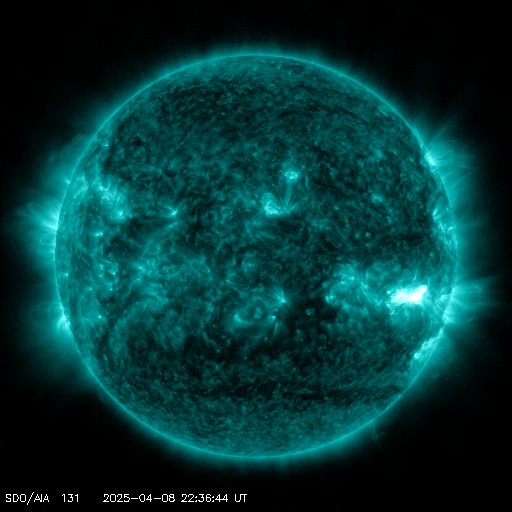Viewing archive of Monday, 7 January 2002
Solar activity report
Any mentioned solar flare in this report has a scaling factor applied by the Space Weather Prediction Center (SWPC). Because of the SWPC scaling factor, solar flares are reported as 42% smaller than for the science quality data. The scaling factor has been removed from our archived solar flare data to reflect the true physical units.
Report of Solar-Geophysical Activity 2002 Jan 07 2200 UTCPrepared by the NOAA © SWPC and processed by SpaceWeatherLive.com
Joint USAF/NOAA Report of Solar and Geophysical Activity
SDF Number 007 Issued at 2200Z on 07 Jan 2002IA. Analysis of Solar Active Regions and Activity from 06-2100Z to 07-2100Z
Solar Activity was at low levels. Region 9767 (S22W30)
produced a C3.8/Sf flare at 07/1422 UTC. Region 9767 has slightly
simplified in structure but retains a beta-gamma magnetic
configuration. Region 9773 (N12E22) shows signs of entering the
decay phase. The large leader spot from yesterday has broken up
into a number of smaller spots. Three new regions were numbered
today: Region 9774 (N12W37), Region 9775 (S06E37), and Region 9776
(N10E59).
IB. Solar Activity Forecast
Solar activity is expected to be at
low to moderate levels. Region 9767 and Region 9773 have the
potential for an M-class event. Two large positive polarity coronal
holes are presently centered along Carrington longitude 355. One
hole is at central latitudes and one at southern latitudes. These
coronal holes will begin rotating into geoeffective position by day
three of the forecast period.
IIA. Geophysical Activity Summary 06-2100Z to 07-2100Z
The geomagnetic field was at quiet to unsettled levels.
IIB. Geophysical Activity Forecast
The geomagnetic field is
expected to be at quiet to unsettled levels with isolated active
conditions possible. Quiet to unsettled conditions are expected for
day one and two of the forecast period. By day three of the period
coronal hole effects could produce an isolated active condition
especially at higher latitudes.
III. Event Probabilities 08 Jan to 10 Jan
| Class M | 55% | 55% | 55% |
| Class X | 10% | 10% | 10% |
| Proton | 10% | 05% | 05% |
| PCAF | green | ||
IV. Penticton 10.7 cm Flux
Observed 07 Jan 189 Predicted 08 Jan-10 Jan 195/200/200 90 Day Mean 07 Jan 221
V. Geomagnetic A Indices
Observed Afr/Ap 06 Jan 003/004 Estimated Afr/Ap 07 Jan 006/008 Predicted Afr/Ap 08 Jan-10 Jan 005/008-005/008-012/015
VI. Geomagnetic Activity Probabilities 08 Jan to 10 Jan
| A. Middle Latitudes | |||
|---|---|---|---|
| Active | 15% | 15% | 25% |
| Minor storm | 05% | 05% | 10% |
| Major-severe storm | 01% | 01% | 05% |
| B. High Latitudes | |||
|---|---|---|---|
| Active | 20% | 20% | 30% |
| Minor storm | 10% | 10% | 20% |
| Major-severe storm | 01% | 01% | 10% |
All times in UTC
Current data suggests there is a slight possibility for aurora to appear at the following high latitude regions in the near future
Gillam, MB, Iqaluit, NUNuuk
Latest news
Latest forum messages
AR4048 128Incoming & Unnumbered Active Regions 1678Sunspot Latitudes at or near Solar Maximum 85New satellites - Proba-3, PUNCH, SWFO-L1, GOES-U/19 47AR 4054 21
More topicsSupport SpaceWeatherLive.com!
A lot of people come to SpaceWeatherLive to follow the Sun's activity or if there is aurora to be seen, but with more traffic comes higher server costs. Consider a donation if you enjoy SpaceWeatherLive so we can keep the website online!

Latest alerts
02:00 UTC - Geomagnetic activity
Minor G1 geomagnetic storm (Kp5) Threshold Reached: 01:45 UTC
Tuesday, 8 April 2025
23:57 UTC - Hemispheric Power Index
The OVATION model predicts the Hemispheric Power Index to reach 50GW at 00:44 UTC
22:42 UTC - Solar flare
Moderate M1.57 flare
22:24 UTC - Radio Blackout
Minor R1 radio blackout in progress (≥M1 - current: M1.52)
15:15 UTC - Geomagnetic activity
Minor G1 geomagnetic storm (Kp5) Threshold Reached: 14:59 UTC
Space weather facts
| Last X-flare | 2025/03/28 | X1.1 |
| Last M-flare | 2025/04/08 | M1.5 |
| Last geomagnetic storm | 2025/04/06 | Kp5 (G1) |
| Spotless days | |
|---|---|
| Last spotless day | 2022/06/08 |
| Monthly mean Sunspot Number | |
|---|---|
| March 2025 | 134.2 -20.4 |
| April 2025 | 151.3 +17.1 |
| Last 30 days | 137.4 +0.1 |





